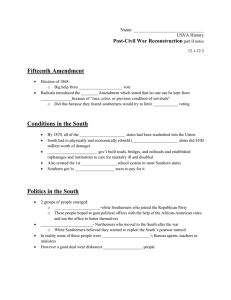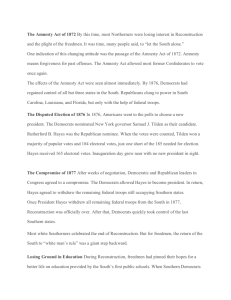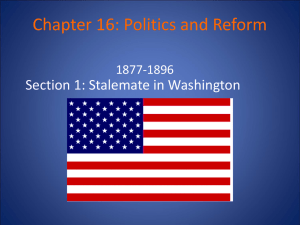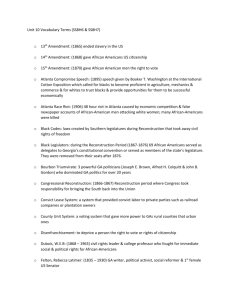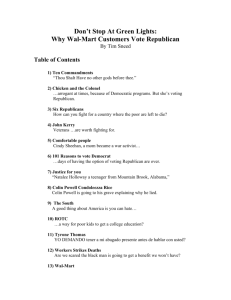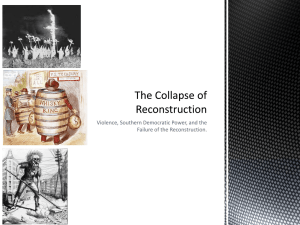US History A New Form of Slavery Takes Root: Equality Is No
advertisement
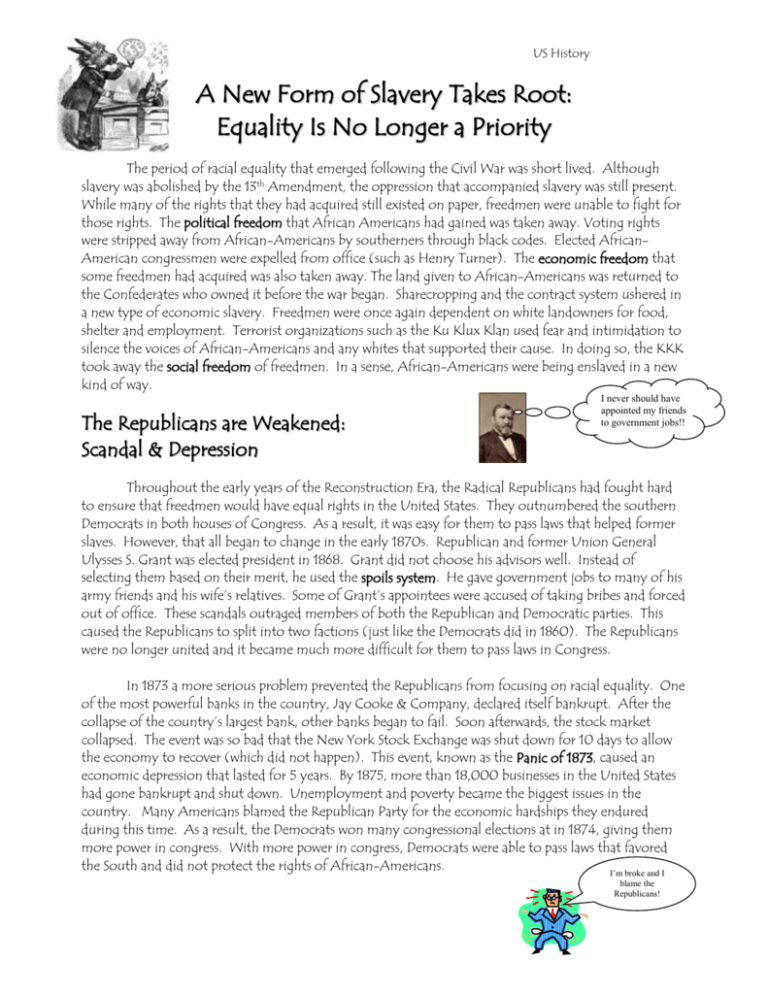
US History A New Form of Slavery Takes Root: Equality Is No Longer a Priority The period of racial equality that emerged following the Civil War was short lived. Although slavery was abolished by the 13th Amendment, the oppression that accompanied slavery was still present. While many of the rights that they had acquired still existed on paper, freedmen were unable to fight for those rights. The political freedom that African Americans had gained was taken away. Voting rights were stripped away from African-Americans by southerners through black codes. Elected AfricanAmerican congressmen were expelled from office (such as Henry Turner). The economic freedom that some freedmen had acquired was also taken away. The land given to African-Americans was returned to the Confederates who owned it before the war began. Sharecropping and the contract system ushered in a new type of economic slavery. Freedmen were once again dependent on white landowners for food, shelter and employment. Terrorist organizations such as the Ku Klux Klan used fear and intimidation to silence the voices of African-Americans and any whites that supported their cause. In doing so, the KKK took away the social freedom of freedmen. In a sense, African-Americans were being enslaved in a new kind of way. The Republicans are Weakened: Scandal & Depression I never should have appointed my friends to government jobs!! Throughout the early years of the Reconstruction Era, the Radical Republicans had fought hard to ensure that freedmen would have equal rights in the United States. They outnumbered the southern Democrats in both houses of Congress. As a result, it was easy for them to pass laws that helped former slaves. However, that all began to change in the early 1870s. Republican and former Union General Ulysses S. Grant was elected president in 1868. Grant did not choose his advisors well. Instead of selecting them based on their merit, he used the spoils system. He gave government jobs to many of his army friends and his wife’s relatives. Some of Grant’s appointees were accused of taking bribes and forced out of office. These scandals outraged members of both the Republican and Democratic parties. This caused the Republicans to split into two factions (just like the Democrats did in 1860). The Republicans were no longer united and it became much more difficult for them to pass laws in Congress. In 1873 a more serious problem prevented the Republicans from focusing on racial equality. One of the most powerful banks in the country, Jay Cooke & Company, declared itself bankrupt. After the collapse of the country’s largest bank, other banks began to fail. Soon afterwards, the stock market collapsed. The event was so bad that the New York Stock Exchange was shut down for 10 days to allow the economy to recover (which did not happen). This event, known as the Panic of 1873, caused an economic depression that lasted for 5 years. By 1875, more than 18,000 businesses in the United States had gone bankrupt and shut down. Unemployment and poverty became the biggest issues in the country. Many Americans blamed the Republican Party for the economic hardships they endured during this time. As a result, the Democrats won many congressional elections at in 1874, giving them more power in congress. With more power in congress, Democrats were able to pass laws that favored the South and did not protect the rights of African-Americans. I’m broke and I blame the Republicans! (weighs in…scales of justice, get it??!!) The Supreme Court Weighs In…. The Supreme Court made several decisions that limited the rights of African-Americans during this time. In the U.S. v. Cruikshank (1876), the court ruled that the federal government could NOT punish people who violated the rights of African-Americans; only states had that power. This gave states an enormous amount of power in dealing with African-Americans’ civil rights. Many southern states would not punish people who violated African-American’s rights – as a result, violence against AfricanAmericans increased dramatically. In U.S. v. Reese (1876) the Supreme Court ruled that states had the power to deny African-Americans their voting rights. The court ruled that the 15th Amendment did not give all people the right to vote, it just said that they could not be denied the right to vote on the basis of skin color. Therefore, states could deny people the right to vote according to other criteria. This led to the passage of more black codes. These new black codes were state laws that denied AfricanAmericans the right to vote through literacy tests (only those who could read and write could vote), poll taxes (charging people a tax to vote) and grandfather clauses (only people whose grandparents had voted could vote). None of these laws were in “direct” violation of the 15th Amendment, because they did deny anyone the right to vote based on “race, color or previous condition of servitude”. The End of Reconstruction… The end of Reconstruction came with the passage o the Compromise of 1877. The Compromise of 1877 was a deal made between Republicans and the southern states. The presidential election of 1876 was too close to call. The southern Democratic Candidate, Samuel Tilden had 184 electoral votes and needed only one more to win. The Republican Candidate, Rutherford B. Hayes, had 166 electoral votes. Three southern states (with a total of 19 electoral votes) had not finished doing a recount. The Republicans needed those electoral votes in order to win. The Democrats agreed to give Hayes and the Republicans the votes in exchange for the following: 1. 2. 3. 4. 5. All federal troops would be removed from the South. The government would help to build a railroad from the South to the West Coast The Federal government would give the South money to help rebuild Hayes would appoint Democrats to his Cabinet Democrats promised to respect the rights of Africans-Americans The Reconstruction Era did result in a reunification of the north and the south, but it did not result in equality for African-Americans. In fact, the inaction of the federal government and the state governments of the South resulted in the further oppression of African-Americans in the U.S. The passage of the 14th and 15th Amendments would provide a legal basis for the Civil Rights Movement, but it would be another 80 years before it would begin. Name: Date: Core: U.S. History The End of Reconstruction: Reflection Questions… Directions: Use the today’s “A New Form of Slavery Takes Root: Equality is No Longer a Priority” handout to answer the following questions in complete sentences. Fact Check… 1. Which political party worked to increase the rights of former slaves during the early years of the Reconstruction Era? ______________________________________________________________ 2. Who was elected president in 1868? _________________________________________________ 3. What two events weakened the power of the Radical Republicans in the 1870s? a. _____________________________________________________________________ b. _____________________________________________________________________ 4. What was the Panic of 1873? _________________________________________________________ _________________________________________________________________________________ _________________________________________________________________________________ 5. Briefly describe the Supreme Court’s verdict in each of the cases below: Case Description of verdict U.S. v. Cruickshank (1876) U.S. v. Reese (1876) 6. What were poll taxes? ______________________________________________________________ 7. What were literacy tests? ____________________________________________________________ 8. Why weren’t poll taxes, literacy tests and grandfather clauses viewed as a violation of the 15th Amendment? _____________________________________________________________________ _________________________________________________________________________________ Reader Response… 1. Why do you think the author chose to subtitle this reading “A New Form of Slavery Takes Root?” Use evidence from the text to support your response (ATITIC) _________________________________________________________________________________ _________________________________________________________________________________ _________________________________________________________________________________ _________________________________________________________________________________ _________________________________________________________________________________ _________________________________________________________________________________ _________________________________________________________________________________ _________________________________________________________________________________ _________________________________________________________________________________ _________________________________________________________________________________ _________________________________________________________________________________ _________________________________________________________________________________ _________________________________________________________________________________ _________________________________________________________________________________ 4 Exemplary Insightful, well organized, and fluent Deep understanding of text is demonstrated Specific references to text are used to support ideas Text references are well interpreted and clearly connected to response 3 Proficient Thoughtful, organized, and fluent Clear understanding of the text is demonstrated Relevant references to text are used to support ideas Text references are explained and connected to response 2 Progressing Organized and somewhat fluent Basic understanding of text is displayed At least one relevant example from text is used to support ideas Text references are somewhat connected to response 1 Beginning Disorganized or confusing Limited or no understanding of text is displayed Limited or no examples from text are used to support ideas Text reference seems irrelevant to response
